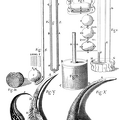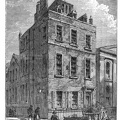A U-tube contains mercury, on which floats a rod supporting a scratching point, which makes a “tracing” on blackened paper wrapped round a revolving drum. Between the manometer and the cannula which is introduced into the central end of a cut artery is a three-way cock, which leads to a pressure-bottle containing a half saturated solution of sodic sulphate. This solution prevents blood from clotting. Before it is connected with the artery the apparatus is filled from the pressure-bottle. The cock is then turned into the second position, and the bottle raised until the mercury in the manometer stands at a level somewhat higher than that which it may be expected to attain under the influence of blood-pressure. The cannula being then inserted into an artery, the cock is turned into the third position, which places the manometer in connection with the blood, and excludes the pressure-bottle. As the mercury is a little higher than blood-pressure, some of the sodic sulphate solution enters the artery, but no blood enters the cannula. The scratching point, rising and falling with every variation in blood-pressure, makes a record on the soot-blackened paper, which is subsequently removed from the drum, and varnished.
- Author
- The Body at Work
by Alexander Hill
Published 1908
Available from gutenberg.org - Posted on
- Tuesday 1 September 2020
- Dimensions
- 750*710
- Tags
- Medicine
- Albums
- Visits
- 3279
- Downloads
- 47
 Download Photo
Download Photo





